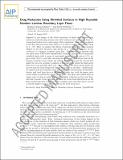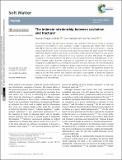Browsing MIT Open Access Articles by Author "Raayai Ardakani, Shabnam"
Now showing items 1-4 of 4
-
Capturing strain stiffening using Volume Controlled Cavity Expansion
Raayai Ardakani, Shabnam; Cohen, Tal (Elsevier BV, 2019-09)Strain-stiffening is a well-documented behavior in soft biological materials such as liver and brain tissue. Measuring and characterizing this nonlinear response, which is commonly considered as a mechanism for damage ... -
Drag reduction using wrinkled surfaces in high Reynolds number laminar boundary layer flows
Raayai Ardakani, Shabnam; McKinley, Gareth H (American Institute of Physics (AIP), 2017-09)Inspired by the design of the ribbed structure of shark skin, passive drag reduction methods using stream-wise riblet surfaces have previously been developed and tested over a wide range of flow conditions. Such textures ... -
The intimate relationship between cavitation and fracture
Raayai Ardakani, Shabnam; Earl, Darla; Cohen, Tal (Royal Society of Chemistry (RSC), 2019-05)Nearly three decades ago, the field of mechanics was cautioned of the obscure nature of cavitation processes in soft materials [A. Gent, Cavitation in rubber: a cautionary tale, Rubber Chem. Technol., 1990, 63, 49–53]. ... -
Volume-controlled cavity expansion for probing of local elastic properties in soft materials
Raayai Ardakani, Shabnam; Chen, Zhantao; Earl, Darla; Cohen, Tal (Royal Society of Chemistry, 2018-12)Cavity expansion can be used to measure the local nonlinear elastic properties in soft materials, regardless of the specific damage or instability mechanism that it may ultimately induce. To that end, we introduce a ...




